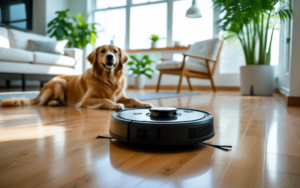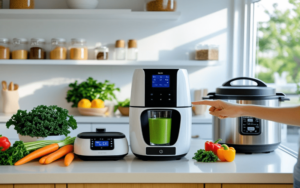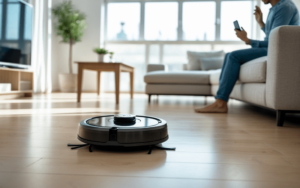Creating a smart home doesn’t have to break the bank. Many affordable gadgets can transform any house into a modern hub of convenience.
By utilizing budget-friendly devices such as smart plugs, smart switches, and automation hubs, anyone can enjoy the benefits of home automation without a substantial investment.
These tools not only enhance daily living but also offer increased control over energy consumption, providing both convenience and potential savings.
Smart home automation offers a tailored approach that suits various needs and budgets.
A diverse array of devices is available, from smart speakers, like the Amazon Echo Dot and Google Nest Mini, to integrated smart cameras and thermostats.
These innovations offer seamless control over multiple aspects of the home, including security, lighting, and temperature, all managed by simple voice commands or mobile apps.
Customizing a smart home setup is made easier with the help of DIY smart technology projects that allow customization and integration within existing frameworks.
Homeowners can choose compatible devices and create schedules and automation schemes that fit their lifestyle, making it an accessible and personalized way to upgrade living spaces.
Embracing these accessible technologies can make any home smarter and more efficient.
Please note that this article contains affiliate links. As an Amazon Associate, we earn from qualifying purchases at no extra cost to you.
Understanding Smart Home Basics
Smart homes combine technology and automation to enhance convenience, efficiency, and security. Key components include smart devices and control systems that communicate with each other to perform tasks with minimal human intervention.
Defining a Smart Home
A smart home is a residence equipped with devices that are connected via the internet to enable remote management.
These devices range from lighting and thermostats to security cameras and appliances.
By allowing homeowners to control aspects of the home through smartphones or voice commands, smart homes offer advanced automation and monitoring capabilities.
The idea is to integrate various devices into one cohesive system that simplifies day-to-day tasks and enhances the living experience.
Benefits of Automating Your Home
Automating a home provides a range of benefits including increased energy efficiency, improved security, and enhanced convenience.
Energy management systems can adjust heating and lighting based on occupancy, reducing unnecessary energy consumption.
Security features, such as cameras and motion sensors, can alert homeowners to unusual activity and be accessed remotely.
Additionally, automation allows for simple, hands-free control over home environments, making day-to-day tasks easier and more efficient for busy individuals or those with mobility challenges.
Core Components of a Smart Home System
A smart home system typically includes key components such as a central hub or platform, smart devices, and a wireless network.
Central hubs, like those offered by Google Home or Amazon Alexa, serve as the control point for the entire setup.
Smart devices include lighting, thermostats, and appliances that are programmable and accessible remotely.
A dedicated wireless network ensures connectivity and security, often isolated from the main internet connection to protect against unauthorized access.
These components work together to create an integrated, responsive home environment.
Choosing Your Smart Home Devices
Selecting the right devices for your smart home is crucial for achieving a seamless and efficient setup. Key areas to focus on include smart assistants and hubs, smart lighting with energy savings, and essential security and monitoring tools.
Smart Assistants and Hubs
Smart assistants and hubs serve as the command center for a smart home. Devices like Amazon Alexa, Google Home, and Apple’s HomeKit allow users to control various smart devices through voice commands or a mobile app.
Choosing the primary system helps in harmonizing all other smart gadgets.
When opting for a smart assistant, consider compatibility with a wide range of smart devices. Some platforms offer better integration capabilities, ensuring that all components work seamlessly together. This ensures smoother operation and reduces the chances of compatibility issues.
It’s also important to balance the cost of these hubs with their features. While some may require an initial investment, they can centralize control and streamline home automation processes.
Smart Lighting and Energy Savings
Smart lighting systems not only enhance ambiance but also drive energy efficiency.
By installing smart bulbs and LED lights, users can adjust brightness and color through an app, making customized lighting scenarios possible. Products such as Philips Hue and LIFX offer versatile options for different settings.
Energy savings is a significant advantage of smart lighting.
By scheduling lights to turn off when not in use or dimming them during peak energy times, homeowners can reduce electricity bills.
Motion sensors can add an extra layer of energy efficiency by automatically controlling lighting based on occupancy.
Security and Monitoring Essentials
Ensuring a secure home environment is a top priority in smart home setups.
Devices such as smart cameras, doorbells, and locks provide real-time monitoring and control from anywhere. Popular options include Ring doorbell cameras and Nest’s range of security products.
We may earn a small commission if you purchase through this link. Thank you for supporting our content!
When choosing security devices, prioritize features like high-definition video streaming, night vision, and reliable mobile alerts.
Integration with other smart devices such as lights or alarms enhances overall security by allowing automated responses to detected threats.
Finally, the placement of cameras or sensors is critical. They should be positioned to cover key entry and exit points for maximum security and monitoring coverage.
Setting Up Your Smart Home Network
Setting up a smart home network requires careful planning, installation, and ongoing troubleshooting. Key considerations include network layout, device integration, and managing connectivity issues to ensure a seamless smart home experience.
Planning Your Home Network Layout
When planning a smart home network, determining the optimal placement of your router is crucial.
The router should be centrally located to cover as many devices as possible with a strong Wi-Fi signal.
Consider using a dual-band router to support multiple devices and reduce network congestion.
Adding range extenders can help reach further distances, especially in larger homes or those with numerous walls.
Mapping out where each device will be placed helps ensure that all devices maintain a steady connection, enhancing the efficiency of the smart home setup.
Installing and Integrating Devices
To install and integrate smart devices, begin by choosing compatible products that work with a centralized platform, such as Google Home or Amazon Alexa.
This compatibility ensures that devices can communicate effectively.
Sync each device with your home network following specific instructions, typically provided by the manufacturer.
Use apps for initial setup and configuration, fostering a seamless connection between devices.
This process may include assigning each device a reserved IP address, ensuring stable performance.
Troubleshooting Connectivity Issues
Addressing connectivity issues efficiently is vital for maintaining a smart home network.
Common problems include weak signals, interference, and device conflicts.
Start by checking the router’s firmware and updating it regularly to improve security and performance.
Interference from other electronic devices can disrupt signals; repositioning the router or switching channels might resolve these conflicts.
If a device disconnects frequently, check if it’s too far from the router or if there’s an issue with network compatibility.
For persistent issues, consulting the device manufacturer’s support or investing in a mesh network could be beneficial.
Mesh networks provide consistent coverage across larger areas by using multiple nodes rather than relying on a single router.
Maintaining and Expanding Your System
Once a smart home system is established, maintaining it regularly and planning its expansion can enhance its functionality. Keeping it updated ensures security, while scalability supports adding new devices or features.
Regular Updates and Security
Updating smart home systems is crucial for security and performance.
Regular firmware and software updates protect against vulnerabilities by patching security flaws. These updates often introduce new features or improvements.
Users should set devices to update automatically whenever possible. Automated updates save time and ensure that devices always run the latest versions.
Security also involves using strong, unique passwords for accounts linked to the system. Multifactor authentication adds an extra layer of protection.
Devices should be monitored for unusual activity to prevent unauthorized access.
Scalability and Adding New Features
A scalable smart home system allows for easy addition of new devices.
Selecting open-source platforms can facilitate expansion by supporting a wide range of compatible devices. Popular platforms like Google Home or SmartThings offer user-friendly expansion options.
When planning additions, consider devices that integrate seamlessly with existing systems. This enhances the functionality and convenience of automation routines.
Adding features like smart lighting or thermostat control can provide energy savings and increased comfort. Users should plan expansions based on their lifestyle and needs.
Community and Support Resources
Engaging with community and support resources can provide valuable insights into managing and expanding smart home systems.
Online forums, such as Home Assistant communities, offer advice from other users.
Manufacturer websites often provide troubleshooting guides and FAQs for common issues. Some brands also offer live support for more complex problems.
Being part of a community keeps users informed about trends and innovations in home automation. This interaction empowers them to make informed decisions about system expansions and maintenance.
Frequently Asked Questions
Exploring DIY smart home automation offers budget-friendly opportunities to integrate voice assistants like Google Home and Alexa. Understanding the essential components and initial steps can help you maximize your investment.
What are the most cost-effective ways to automate your home?
Affordable automation can be achieved by investing in devices like smart bulbs and smart plugs.
These can be controlled via apps or voice assistants, offering convenience without significant expense. Additionally, DIY projects using platforms like Raspberry Pi can further customize your setup.
Which budget-friendly smart home devices work best with Google Home?
Devices like the Google Nest Mini and smart bulbs from Philips Hue seamlessly integrate with Google Home.
These devices allow users to control lighting and more with simple voice commands, providing an efficient and cost-effective smart environment.
We may earn a small commission if you purchase through this link. Thank you for supporting our content!
How can Alexa be used to create an affordable smart home system?
Alexa supports a wide range of budget-friendly devices such as smart plugs and thermostats.
Utilizing skills and routines, users can automate tasks and manage their home settings, creating a cohesive and affordable smart system.
What are the initial steps to converting my house into a smart home?
Start by identifying which areas you want to automate and the devices that fit those needs.
Often, beginning with a smart hub or speaker allows integration of various technologies. Gradually expand with additional devices like smart cameras or locks.
What are essential components of a DIY home automation kit?
A typical DIY home automation kit may include smart speakers, smart plugs, and control hubs.
Platforms like Mycroft provide open-source options that allow for customizable projects to suit specific home requirements.
How much should I budget for basic smart home automation?
A modest investment of a few hundred dollars can start your smart home transformation.
Key expenditures include smart speakers and lighting systems.
More advanced setups involving cameras or security systems may require additional budget consideration.
This article contains affiliate links, which means we may earn a commission if you purchase through our links, at no extra cost to you. As an Amazon Associate, we earn from qualifying purchases. Thank you for supporting our content!




